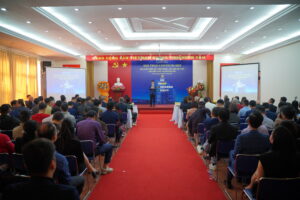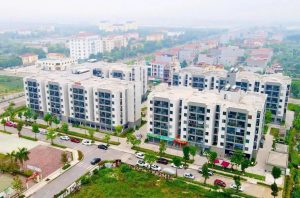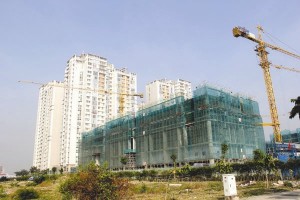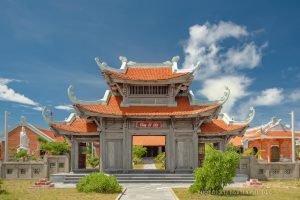Công bố quốc tế trong lĩnh vực kiến trúc, xây dựng (Tuần 4 tháng 9-2021)
Trong số này chúng tôi xin giới thiệu tới quý độc giả những nội dung chính của các công bố quốc tế đăng tải trên ScienceDirect và Springer Nature do Cục Thông tin khoa học và công nghệ quốc gia (NASATI) mua quyền truy cập như sau:
Quy hoạch đô thị:
– Lập kế hoạch và ưu tiên bổ sung nguồn cung cấp năng lượng cho các thành phố trong tương lai
– Lập bản đồ các thành phố hỗn hợp thông qua các công nghệ dựa trên vị trí: Đánh giá có hệ thống các tài liệu
– Nhu cầu không gian xanh đô thị ngày càng cao và không đồng nhất của cư dân đô thị Trung Quốc: Bằng chứng từ Bắc Kinh
– Đánh giá hiệu quả hoạt động đô thị dựa trên các thước đo tuyệt đối về tính bền vững – Đánh giá
– Việc mở rộng đường cao tốc có góp phần gây ô nhiễm khói mù đô thị không? —— Bằng chứng từ các thành phố Trung Quốc
– Sự cân bằng giữa phát triển kinh tế và giá trị dịch vụ hệ sinh thái trong quá trình đô thị hóa đất: Một nghiên cứu điển hình về quá trình đô thị hóa trên đất của Trung Quốc từ năm 2000 đến năm 2015
– Mô hình động cơ tái tạo đô thị: Khung phân tích và nghiên cứu điển hình về việc đổi mới các cộng đồng cũ
– Đánh giá tính bền vững của các dự án đổi mới đô thị dựa trên mô hình ra quyết định đa thuộc tính kết hợp
– Đóng góp của không gian xanh và cây xanh tập trung vào kết nối cảnh quan trong cảnh quan đô thị
– Xem xét lại tác động làm mát của phủ xanh đô thị: Ý nghĩa quy hoạch của các loại thảm thực vật và cấu hình không gian
Khoa học và công nghệ trong lĩnh vực kiến trúc, xây dựng:
– Hiệu suất địa chấn của tường xây hạn chế có gia cố khớp và tỷ lệ khía cạnh: Một nghiên cứu thực nghiệm
– Khung tính toán tự động chi phí khắc phục vòng đời của các vết nứt lớp lót thứ cấp
– Lập bản đồ khoa học về nghiên cứu tòa nhà thông minh: Hướng tới một khuôn khổ hệ thống vật lý – mạng của con người (HCPS)
– Phương pháp điều phối robot xây dựng theo định hướng thông minh cho nhà tiền chế
– Phân loại bề mặt hoàn thiện bằng cách sử dụng dữ liệu máy ảnh độ sâu
– Ba phương pháp chế tạo rô bốt hợp tác để xây dựng vòm xây không cần giàn giáo
– Máy học kết hợp để dự báo lực kéo lùi trong quá trình khoan định hướng ngang
– Khắc đá bằng robot thích ứng: Phương pháp, công cụ và thí nghiệm
– Phát triển hệ thống quản lý vòng đời tòa nhà hỗ trợ BIM cho chủ sở hữu: Kiến trúc và tình huống
– In 3D vữa có sợi liên tục: Nguyên lý, tính chất và tiềm năng ứng dụng
Vật liệu xây dựng:
– Thực nghiệm và khảo sát số liệu về ứng xử uốn của ống thép hình elip đổ bê tông (CFET)
– Đánh giá hiệu suất nhiệt theo thời gian thực của mái bê tông xi măng cốt thép trong mùa hè – một nghiên cứu ở vùng khí hậu ấm ẩm của Kerala
– Nhà tiền chế so với xây dựng thông thường: So sánh tác động vòng đời của các vật liệu kết cấu thay thế
– Nghiên cứu so sánh tính năng cơ học của các mối ghép bu lông bằng thép và bu lông polyme cốt sợi
– Hiệu suất năng lượng của vải polyester tráng PVC làm vật liệu mới cho vỏ tòa nhà: Xác nhận mô hình và nghiên cứu trường hợp tân trang
– Nghiên cứu thực nghiệm các tính chất cơ học của mối nối vữa phụt bằng vật liệu phụt vữa cốt sợi
– Khảo sát tính năng chịu uốn của dầm liên hợp bê tông tre với tấm bê tông nhẹ đúc sẵn và đầu nối chốt
– Tăng cường cơ học cho vật liệu kết dính hấp thụ EMW bằng cách sử dụng in bê tông 3D
– Khả năng biến dạng cộng dồn của kết cấu thép chịu tác dụng của biến dạng biên độ cực lớn
Xin trân trọng giới thiệu!
QUY HOẠCH ĐÔ THỊ
- Planning and prioritizing of energy retrofits for the cities of the future
Cities, Volume 116, September 2021, 103272
Abstract
In the cities of the future, public administrations play a key role both because they implement political and legislative choices, and because they must represent the virtuous example to follow. Related to the planning and prioritizing of public buildings energy retrofits, public administrations must support a transition process. In this viewpoint, authors proposed an approach by defining three postulates, or pillars, based on the concept of transdisciplinary, that is knowledge, planning and sharing of the city. These pillars could have a significant impact and positive effect in a number of areas and could bring to economical, social and environmental sustainability. It also encourages the development and transfer of knowledge and technology in the main topic of the cities of the futures.
- Urban nexus and transformative pathways towards a resilient Gauteng City-Region, South Africa
Cities, Volume 116, September 2021, 103266
Abstract
The challenges emanating from the rapid urbanisation of the Gauteng City-Region in South Africa require innovative strategies to transform the urbanised province into a climate action and adaptation centre. We provide an analysis of the impacts of rapid urbanisation in the Gauteng City-Region, highlighting major challenges related to (i) land use management, (ii) service delivery (water, energy, food, and waste and sanitation), and (iii) social cohesion, applying geospatial techniques to assess spatio-temporal changes and variations in land surface temperatures. Massive impervious surfaces, rising temperatures, flooding and heatwaves are compounding the challenges associated with rapid urbanisation in the city region. We provide an outline of the response pathways towards a sustainable and resilient city-region and inform policy on formulating coherent adaptation urban planning strategies. If not well managed, rapid urbanisation could be a huge environmental and human health risk and a threat to sustainable cities by 2030. Nexus planning is proposed to provide the basis to achieve urban resilience as it integrates distinct, but interlinked sectors, considering both ecological and built infrastructures, in a balanced and integrated manner.
- Mapping hybrid cities through location-based technologies: A systematic review of the literature
Cities, Volume 116, September 2021, 103296
Abstract
Over the past two decades, the development of a new set of technologies, devices and applications has supported the emergence of a new infocommunicational landscape in cities—one of the key fuels to the growth of smart cities movement. Digital media platforms, ubiquitous technologies and geographic annotation technologies have blurred the boundaries of virtual and physical environments—with an access through digital devices and specifically mobile devices. The paper aims to investigate the emerging location-based and mapping technologies to develop a clearer understanding on their applicability in the urban context by identifying and categorizing the key drivers based on desired outcomes. In order to achieve this aim, the study undertakes a systematic literature review on the planned and applied use of location-based technologies for mapping urban environments. In doing so, the paper outlines the spatial distribution of these advanced technologies across globe, and presents a synthesis of the emerging themes and categories, and potential avenues for future research. The study findings reveal three types of mapping approaches—i.e., reason-oriented, sense-oriented and community-oriented—that are linked to two modes of use—i.e., desktop and in-situ.
- The rising and heterogeneous demand for urban green space by Chinese urban residents: Evidence from Beijing
Journal of Cleaner Production, Volume 313, 1 September 2021, 127781
Abstract
Studies using Hedonic housing price model to discuss residents’ demand for urban green space (UGS) demonstrate the importance that residents place on UGS. While much of the empirical findings have focused on residents’ willingness to pay, more attention needs to be paid on its temporal change and spatial heterogeneity. Taking advantage of the diverse composition of urban parks, housing, and residents in Beijing, this paper explores the dynamic and heterogeneous demand for UGS. Using more than 240 thousand micro housing resale transaction data from 2011 to 2019, this paper constructs a Hedonic model to empirically estimate and confirm the basic, dynamic and heterogenous willingness to pay of residents for urban parks. Our empirical findings confirm the rising and heterogeneous demand for UGS by Chinese urban residents. First, the willingness to pay for parks of urban residents has continued to grow during our study period. Second, in view of different socioeconomic characteristics, there exists heterogeneous demand related to the housing of residents and different types of parks. Residents who live in homes with a larger size have a stronger demand for urban parks. Meanwhile, urban residents prefer parks with free entry over fee-based parks, and they have strong preference for some specific types of parks. Moreover, we conduct a survey and collect 907 valid samples to directly obtain residents’ willingness to pay for urban parks, and the survey results further confirm the abovementioned findings. This study deepens the understanding of urban residents’ demand for UGS, and will contribute to more scientific decision making on the planning, financing and management of UGS.
- Benchmarking urban performance against absolute measures of sustainability – A review
Journal of Cleaner Production, Volume 314, 10 September 2021, 128020
Abstract
Cities are a key target in the global quest for sustainability and are increasingly acting independently to take the lead in sustainability initiatives. To truly achieve sustainability, cities need to ensure that their consumption is compatible with absolute sustainability and validate achievements from a perspective that includes transboundary impacts. The aim of this review is to assess how well these topics are incorporated into commonly used urban sustainability assessment methods, using the safe and just space (SJS) framework definition of a minimum acceptable threshold for both ecological stability and standard of living. The review identified 277 different sustainability indicator frameworks that have been applied to cities and undertook a detailed assessment of the most commonly cited of these. Consumption-based footprint studies were separately assessed to determine the extent to which they measure SJS indicators for cities. Both indicator frameworks and footprint studies had a focus on boundaries of increasing risk, including carbon, water, and land use; however few measured highly exceeded boundaries including nitrogen and phosphorus use, biodiversity, and possibly chemical pollution. Social impacts were well covered in indicator frameworks, except food intake, but largely absent from footprint studies. Cities are largely not measuring their impact on planetary tipping points or transboundary impacts, risking resolving some environmental issues while exacerbating others.
- Does the expansion of highways contribute to urban haze pollution?——Evidence from Chinese cities
Journal of Cleaner Production, Volume 314, 10 September 2021, 128018
Abstract
Rapid highway expansion in China has contributed positively to economic development; however, it also created environmental pollution problems. This study used direct and indirect perspectives to analyze the impact that highway expansion had on haze pollution and the mechanisms involved. To consider the spatial spillover effect of haze pollution, panel data for 283 cities in China from 2003 to 2016 served as a research sample for regression analysis, based on the spatial Durbin model. Empirical results revealed three key results: 1) The overall relationship between highway expansion and haze pollution in local cities and neighboring cities formed an inverted U-shape: as highway density increased, haze pollution first increased and then decreased; 2) The results of the mediation effect assessment identified three mechanisms by which highway expansion affected haze pollution: the transport effect, the industrial structure effect, and the market segmentation effect; and 3) Heterogeneity analysis revealed that highway expansion decreased haze pollution in central and western cities, inland cities, and in non-resource cities. The conclusions of the work were supported by conducting a robustness test of the regression results, using the generalized space two-stage least square (GS2SLS) method and other methods. Given the possible continued expansion of China’s highways, this research has a guiding significance for changing the highway expansion model.
- Combining behavioral interventions with market forces in the implementation of land use planning in China: A theoretical framework embedded with nudge
Land Use Policy, Volume 108, September 2021, 105569
Abstract
Land use planning has become an important topic for research in China and a critical public management means to restrain and regulate land use behavior. China’s current land use planning can be divided into different levels of planning, that is, national planning and local planning. The central government designs land use planning that emphasizes control and longer-term goals; whilst local governments tend to have shorter planning time scales and more market-oriented goals. This government-led type of planning system often caused mismatches between supply and demand and planning failures. This is a challenge facing researchers and policy makers in China at all levels. In this paper we propose the use of nudges as a new approach of government interventions to tackle this problem. We develop a theoretical framework to embed nudges in land use planning, and use Zhejiang Province as a case study to demonstrate the empirical implementation of the framework. We argue that nudge-based government interventions are efficient and effective alternatives for conventional, direct administrative orders. It facilitates decisions that can both improve private welfare and protect public interests; it strikes a balance between government interventions and market forces while still preserves the freedom of choices. It is a promising direction for the research and practice of land use policy in China and beyond.
- LADM for sustainable development: An exploratory study on the application of domain-specific data models to support the SDGs
Land Use Policy, Volume 108, September 2021, 105499
Abstract
Summary
Individual land titling will not deliver land tenure security to the majority of people by 2030. Nevertheless, tenure security is implicit to the 2030 Agenda for Sustainable Development and deep-rooted in the Sustainable Development Goals (SDGs). Land tenure security underpins the SDGs related to poverty reduction, food security, disaster risk management and gender equality. The cross-cutting benefits of land tenure security with regards to sustainable development suggests equally cross-cutting conceptual frameworks, management cooperation and data sharing are needed within, and between, those sectors. Additionally, previous research in the land administration domain developed approaches, frameworks and data models linking across different domains. This latter achievement showed how developments using standardised modelling approaches and domain terminologies can be used to support gathering, organising and disseminating information relevant to reporting on and monitoring of the SDGs. From the perspective of data sharing, domain models – such as the Land Administration Domain Model LADM (ISO 19152), a globally recognized standard – are seen as supporting this capability. In response, this paper explores whether and how LADM, in terms of data model additions and adaptations, could support other SDG-relevant domains. The approach used is exploratory, including elements of literature review, case study analysis, conceptual data modelling, and synthesis. It shows the potential and added value of an integrated data modelling approach, with regards to Land Administration and its intrinsic feature to other fields of study including poverty reduction, food security, and gender equality.
- Design and implementation of 3D strata objects registration based on LADM – A case study in Malaysia
Land Use Policy, Volume 108, September 2021, 105497
Abstract
This paper discusses 3D strata objects registration and implementation within the Land Administration Domain Model (LADM) framework in Malaysia. LADM – ISO 19152:2012 provides a conceptual description for a land administration system, including 3D strata objects registration. Standardization provides flexibility to the data model, making it easier for spatial data handling. The main concern of this research is the conceptual model which has yet to be implemented by the national authority. This research will discuss the practical pathway towards realizing LADM-based 3D strata objects registration in alignment with the jurisdictional settings in Malaysia. An accurate 3D cadastre for a property including strata has become important for the land administration system. Strata objects registration has the following aspects – parcel unit, accessory unit, common property unit, limited common property unit and land parcel. Presently, in Malaysia, all these objects’ representation is in 2D. This paper focusses on extending the representation of those strata objects to 3D. The prototype development begins with the data modelling i.e. selecting relevant object classes and extending the classes with attributes. It focuses on data conversion from an existing database i.e. strata.xml format to an open source database (i.e. PostgreSQL). The visualization and application modules will then be developed using an open source platform (i.e. QGIS). The developed prototype is able to answer all questions related to strata aspects which include ownership, share unit, Management Corporation (MC), spatial source document and strata objects. We anticipate that this work could serve as the model for other national authorities having similar land administration systems especially strata objects registration including the future Spatial Data Infrastructure (SDI) initiative in Malaysia.
- The balance between economic development and ecosystem service value in the process of land urbanization: A case study of China’s land urbanization from 2000 to 2015
Land Use Policy, Volume 108, September 2021, 105536
Abstract
Beginning in the 21st century, the world entered a stage of the rapid development of land urbanization. In general, land urbanization sacrifices ecosystem service value for economic value. Optimizing the spatial pattern of land urbanization is the best means of balancing economic development and ecosystem service value. Taking China as an example, through remote sensing and GIS methods, this paper studies the basic situation of regional land urbanization and the distribution of other types of ecosystems from 2000 to 2015, assessing the relationship between the characteristics of regional land urbanization and economic growth and the value cost of ecosystem services. The results show that the spatial differences of land urbanization practices in China is significant and that the extensive development of land urbanization is a serious issue; the urbanization speed of provinces and cities with a larger scale of land urbanization is faster; the intensive, economical and centralized utilization of land urbanization is an effective way to improve GDP per unit area; and the ecosystem service value cost of land urbanization varies significantly among different ecosystem types and regions. For example, the loss of the ecosystem service value of wetland ecosystems due to land urbanization is the greatest, and the cost of the ecosystem service value of Inner Mongolia per 100 million yuan of new GDP is 13.1-fold that of Shanghai. Therefore, to improve the GDP output per unit area and reduce the value cost of ecosystem services, this study draws a series of conclusions and puts forward corresponding policy suggestions that clarify the development mode and priority development area of land urbanization.
- The Urban Regeneration Engine Model: An analytical framework and case study of the renewal of old communities
Land Use Policy, Volume 108, September 2021, 105571
Abstract
The regeneration of old residential areas in China is facing a complex trap involving all kinds of stakeholders. On the one hand, ambiguous property rights, huge infrastructure investment arrears, and strict urban planning regulations make it challenging for market forces and social capital to enter the field of regeneration of old residential areas. On the other hand, the lack of an effective urban governance and social mobilization system leads to governance failures in the regeneration process. To break out of the above traps theoretically and practically, we construct an analytical framework called the Urban Regeneration Engine Model, in which the city government and the urban regeneration operator act as dual engines of urban regeneration. This dual engine drives the increase in social capital in the regeneration process and promotes the participation of the government, enterprises, residents, social organizations, and financial institutions. The positive feedback that comes from social capital increase further diversifies the fundraising sources, reduces the governance cost, and promotes the sustainable development of the community. Taking the Jinsong Community, one of the earliest residential communities in Beijing after the reform and opening up, as an example, this paper shows that the Urban Regeneration Engine Model provides a feasible and effective model for the regeneration of old residential areas in China and other developing countries facing similar problems.
- Evaluating the sustainability of urban renewal projects based on a model of hybrid multiple-attribute decision-making
Land Use Policy, Volume 108, September 2021, 105570
Abstract
Sustainable urban renewal has received tremendous academic attention and has been put into wide practice around the world. In order to avoid unsustainable renewal projects, the evaluation of the sustainability of urban renewal has become a critical procedure. However, there is an insufficient number of relevant studies on ex-ante evaluation compared to a large amount of literature focusing on ex-post evaluation. Most literature does not fully consider the interdependency between the dimensions/criteria of evaluation. How to utilize this to evaluate real cases is shortage. Hence, this study presents an ex-ante decision-making model for evaluating the sustainability of urban renewal projects based on hybrid multiple-attribute decision-making (MADM) from a government perspective, and includes three classical dimensions: economic (D1), social and cultural (D2), and environment (D3), as well as 13 relevant criteria. A case in Taiwan is used to evaluate the potential performance of sustainability and explore improvement strategies. Empirical results from the Decision Making Trial and Evaluation Laboratory (DEMATEL) reveal that the social and cultural (D2) dimension impact the environment (D3) and economic (D1) dimensions, with the economic (D1) dimension being the most impacted by other dimensions. Enhancing transportation (C5), strengthening the accessibility of various public facilities (C4), preserving local culture (C9), increasing greening and open space (C10), and improving land-use efficiency (C3) are the criteria in the “cause” position, among which strengthening the accessibility of various public facilities (C4) and improving land-use efficiency (C3) are considered to be the core of urban renewal project sustainability based on DEMATEL and the DEMATEL-based analytic network process (DANP). The modified VlseKriterijumska Optimizacija I Kompromisno Resenje (VIKOR) method indicated that the social and cultural (D2) and the environment (D3) dimensions have poor performance. Thereafter relevant improvement strategies and paths are suggested based on an influence network relation map (INRM). The results imply that recent urban renewal policy reform in Taiwan represents a step toward sustainable development.
- Tackling urban disparities through participatory culture-led urban regeneration. Insights from Lisbon
Land Use Policy, Volume 108, September 2021, 105478
Abstract
In the last few decades, the diffusion of culture-led urban regeneration schemes has intercepted the growth of participatory approaches across a wide range of policy domains. Partnerships between private and public agencies have sought, accordingly, the engagement of citizens and stakeholders to push forward context-specific interventions. From the participatory action research developed in Lisbon, one of the cities funded under the EU-funded project ROCK, we analyse the ways in which this project has tackled spatial divides and socioeconomic inequalities in the project demonstration area. Our main argument is that operational decisions and substantive mismatches have given rise to opportunities and bottlenecks throughout the implementation of the project. While the public investment has been directed to regenerate a deprived area, it has fallen short of promoting greater connections within the area and with the surrounding neighbourhoods. ROCK’s actions have only partially met local community expectations regarding the project’s objectives for the optimisation of tangible and intangible cultural heritage, with impacts over degrees of citizen engagement in the local Living Lab.
- Spatial mismatch analyses of school land in China using a spatial statistical approach
Land Use Policy, Volume 108, September 2021, 105543
Abstract
Given the continuous migration of populations from rural areas to urban areas and parents’ need to decide on schools, the phenomenon of a spatial mismatch between supply of and demand for school land prevails in many countries. This can cause waste of land resources in regions with oversupply of school land and a lack of educational facilities in regions with undersupply. National and local government authorities utilize different means to explore this spatial mismatch problem and balance the allocation of education resources through land-use policy interventions. This study presents a quantification procedure and measurement technique for school land spatial mismatch through spatial statistics. Specifically, the supply–demand balance of school land is evaluated in the context of population migration. In addition, the spatial statistics reveal whether there is spatial clustering of oversupplied and undersupplied schools. Consequently, the adjustment of school land in cluster areas can be achieved in stages based on a key set of spatial mismatch analyses. This measurement is applied in Yuncheng County and it is found that there is a spatial clustering of mismatched schools and that the adjustment strategy should focus on the areas where spatial clustering has occurred and will occur in the future. The proposed framework enables national and local authorities to identify and prioritize the areas with school land mismatches to ensure efficient management of school land resources and fair allocation of educational facilities.
- Freight operations in city centers: A land use conflict in urban planning
Land Use Policy, Volume 108, September 2021, 105575
Abstract
Municipalities in Colombia have insubstantially developed methods and technical support to diagnose and plan the supply chain in consolidated urban spaces. This situation becomes critical due to strong illegal occupation and deterioration of public space, overcrowding by vulnerable populations, informal commerce and common delinquency. This research paper aims to present a diagnosis of loading and unloading operations in Cali’s city-center and, subsequently, to study some improvement strategies considering stakeholders’ opinion. A combination of methodologies permitted obtaining relevant results that shed light on possible innovative actions to reduce land use conflict in city centers of medium sized cities in emerging countries. The results revealed that the freight parking offer was very scarce and concentrated on bay infrastructure and on-street parking, increasing waiting times and congestion. Parking was not controlled, and illegal practices were present throughout the day, including pedestrian path occupation. A combined set of strategies, such as cargo cycle operation and mini-hubs, could raise the parking offer and adapt to different demand conditions in terms of schedules and vehicles sizes. Cooperation between private stakeholders and the strength of institutional structure is essential to harmonize urban freight evaluations and operations with sustainable mobility policies in city centers. Some strategies require a strong set of public incentives, including tax benefits and logistic land use implementation with price controls. City Centers requires loading and unloading zones and logistic land, besides traffic management policies. Logistic land use is disappearing in central urban zones, which is contradictory and is producing a perverse effect. This is an analysis that reveals the importance of planning mixed land uses that include logistics and different vocations of public space.
- Contributions of green spaces and isolated trees to landscape connectivity in an urban landscape
Urban Forestry & Urban Greening, Volume 64, September 2021, 127277
Abstract
Vegetation plays a fundamental role in conserving the biological diversity of urban areas. From isolated trees to multi-hectare patches, green spaces are critical to species conservation in urban landscapes. The abundance of green spaces can regulate the availability of habitat and resources for species’ survival. In many urban areas, the lack of vegetation inventories and ecological information at fine spatial resolutions limits conservation efforts. To evaluate the potential of very high-resolution imagery (WorldView-2, 30-cm resolution) to fill this gap, we sought to a) map contrasting urban vegetation cover types (grass, shrubs and woody vegetation) at the meter scale and with high accuracy, b) quantify the structural and functional connectivity of urban vegetation, and c) estimate the status of productive vegetation. We focused our analysis on land use and cover in the city of Xalapa in Veracruz, Mexico, and employed multiscale satellite imagery to estimate vegetation cover, connectivity, and health. We identified 38,579 patches of woody vegetation, of which 93 % corresponded to isolated trees contributing to 27 % of vegetation connectivity. Without woody vegetation, the connectivity index decrease up to 97 %; removing grass or shrubs would reduce connectivity by 38 % or 32 %, respectively. We identified 10 patches disproportionately important to connectivity, of which seven had some type of legal protection. Across vegetation types, 38 % of the vegetated area was unhealthy. Wooded element connectivity assessment at a fine spatial resolution is crucial to conserve and restore these key resources for biodiversity and human well-being in urban environments.
- Revisiting the cooling effects of urban greening: Planning implications of vegetation types and spatial configuration
Urban Forestry & Urban Greening, Volume 64, September 2021, 127266
Abstract
While it is well recognised that increasing vegetation cover reduces the Urban Heat Island (UHI) effect in cities, less is understood about the spatial pattern of vegetation type required to maximise cooling benefits. This study examines how different urban vegetation spatial configuration and composition impact on the UHI phenomenon. We investigated this on a set of sites in Metropolitan Melbourne, Australia. Urban vegetation raster data at 20 cm resolution was used to define five height-based vegetation cover types (grass, shrub, small, medium and large trees); and to calculate eight landscape metrics: percentage of landscape (PLAND), mean patch area (AREA_MN), patch density (PD), edge density (ED), mean patch shape index (SHAPE_MN), mean Euclidean nearest-neighbour distance (ENN_MN), Shannon’s diversity index (SHDI) and Landscape shape index (LSI). These vegetation landscape metrics of vegetation types were established as independent variables and statistically analysed with the UHI intensity as the dependent variable using Classification and Regression Tree analysis (CRT). The CRT model was developed based on 6469 records and including depth of 5, 41 nodes and 21 terminal nodes. From the total 43 independent variables, 11 were identified as high impact factors on UHI intensity. Our findings revealed a consistent negative statistical relationship between UHI intensity and PLAND-landscape, PLAND-large tree and PLAND-medium tree across the study sites. The PLAND, ED and AREA_MN were the most prevalent metrics to explain UHI effect, which has also principally demonstrated the joint impact of the three metrics on UHI effect. This study presents a new framework of a fine-scale assessment and modelling for the impact of urban vegetation on UHI; and elaborates a practical approach of using CRT technique to design local-based UHI mitigating strategies taking advantage of different vegetation structure.
KHOA HỌC VÀ CÔNG NGHỆ TRONG LĨNH VỰC KIẾN TRÚC, XÂY DỰNG
- Compressive behavior of heat-damaged square concrete prisms confined with basalt fiber-reinforced polymer jackets
Engineering Structures, Volume 242, 1 September 2021, 112504
Abstract
Externally bonded fiber-reinforced polymer (FRP) composites are increasingly used to confine concrete columns as an effective strengthening technique. During the past two decades, a significant research effort has focused on the performance of FRP-strengthened concrete structures under fire exposure. However, there is still a lack of research on the structural behavior of heat- or fire-damaged concrete structures repaired with FRP composites. This paper presents the results of the first-ever experimental study on the compressive behavior of heat-damaged square concrete prisms that are either unconfined or confined by a promising type of FRP composites made of basalt fibers. A total of 51 specimens were prepared and tested under axial compression. The design variables included the heat-induced damage levels of concrete prisms after exposure to various elevated temperatures (200, 400, 600 and 800 °C) and the layers of basalt FRP (BFRP) jackets (2-, 3- and 4-layer) used for strengthening. The failure modes, compressive strengths, ultimate axial strains, axial stress–strain curves, and axial strain-to-hoop strain relationships of the specimens were investigated and compared. The external confinement of the BFRP jackets was proved to be effective in enhancing the strength and deformation capacities of heat-damaged concrete with a square cross-section. The strength growths and the ultimate axial strains of the BFRP-confined heat-damaged square concrete prisms were improved with the increase in the exposure temperature or the number of BFRP jacket layers. Two typical concrete confinement models were then modified by taking the residual mechanical properties of concrete into account to predict the compressive behavior of the BFRP-confined heat-damaged concrete with a square cross-section. The comparisons between the test results and the model predictions are presented, and the accuracy of the concrete confinement models are examined and discussed.
- Seismic performance of confined masonry walls with joint reinforcement and aspect ratio: An experimental study
Engineering Structures, Volume 242, 1 September 2021, 112484
Abstract
The effect of joint reinforcement, aspect ratio and their possible interaction, on the performance of confined masonry walls, was studied experimentally. Eight full scale confined masonry walls with four different height-to-length aspect ratios ( = 1.46, 1.0, 0.59, 0.4) and two different amounts of horizontal reinforcement per aspect ratio ( were subjected to reversible cyclic shear loads and a fixed axial stress, representing the vertical load of five stories. The walls with were included from a previous study.
The aspects ratios considered correspond to slender walls, square walls, long walls with one masonry panel and long walls with two masonry panels. Multiperforated concrete masonry units with 75% of net area were used. The performance of the walls is described in terms of strength, strength degradation, displacement capacity, ductility, dissipated energy, stiffness degradation, joint reinforcement (JR) deformation, cracking patterns, and crack opening.
The results show that JR increased the shear strength of the walls and, in most cases, it had a negative impact on ductility; however, ductility increased as the aspect ratio decreased. Drift at peak strength increased with JR, and it had a clear tendency to grow as the walls were longer. Long walls tend to have a more brittle behavior.
A detailed description of the experimental program and the results are given, after which, some conclusions are drawn.
- A framework for automatic calculation of life-cycle remediation costs of secondary lining cracks
Automation in Construction, Volume 129, September 2021, 103714
Abstract
This paper proposes the framework for automatic calculation of secondary lining cracks remediation costs. A study focuses on the structural cracks resulting from the tunnel secondary lining overloading due to rock mass creep. It is based on the multi-phase workflow combining the on-site measurements of behavior of the rock mass surrounding the tunnel and advanced numerical modelling tools assisted by the custom custom-made neural network, as well as the cost calculations. The workflow is established through the developed TunnCrack LCC platform where the data communication protocols between phases provided the straightforward and automatic data flow. Based on the evaluated long-term behavior of a tunnel, the secondary lining crack repair cost could be calculated for the different crack widths. The established platform presents a step forward in proactive estimation of the secondary lining remediation costs, where the monitoring data is continuously used to enhance the estimates of the crack repair costs, providing the tunnel managers with information on lining remediation life cycle costs, thus easing the overall decision-making process.
- Game theory–based bilevel model for multiplayer pavement maintenance management
Automation in Construction, Volume 129, September 2021, 103763
Abstract
Pavement maintenance is widely thought to be critical for promoting their sustainability. It plays a pivotal role in sustainable and resilient transportation infrastructure for economic development and social inclusion improvement. Existing research mainly focuses on optimizing the maintenance strategies based on one player but ignores the inherent conflicts and complex interactions among multiplayer decision-makers. To address these issues, this research examined the problem of pavement maintenance involving the highway agency and maintenance service providers under the uncertainty of pavement conditions with the aim of optimizing maintenance strategies. A novel bilevel mathematical model was proposed to handle the inherent conflicts and complex interactions among decision-makers based on the Stackelberg game and Nash game. The goal is to obtain the Stackelberg–Nash equilibrium solution, where the highway agency, as the upper-level leader, determines the maintenance tasks, whereas the service providers, as the lower-level followers, provide the corresponding maintenance activities. To formulate this complex model, a bilevel particle swarm optimization (BLPSO) algorithm was developed for pavement maintenance. Finally, a practical case was used to demonstrate the practicality and efficiency of the proposed model. The results show that the mathematical model can provide feasible and effective pavement maintenance strategies for multiplayer decision-makers in real-world applications.
- Scientometric mapping of smart building research: Towards a framework of human-cyber-physical system (HCPS)
Automation in Construction, Volume 129, September 2021, 103776
Abstract
This paper reviews the state-of-the-art smart building research by a bibliometric analysis, a content analysis, and a qualitative review. The bibliometric analysis of 364 academic papers shows that smart building is a burgeoning, interdisciplinary field with a relatively high international collaboration level. Keyword’s clustering identified two major themes: (1) IoT, WSN, and cloud computing for automation control and (2) the balance between energy efficiency and human comfort based on continuous monitoring and machine learning. The content analysis statistically detected a transition from the cyber-physical system (CPS) to the human-cyber-physical system (HCPS) in smart building research. We therefore proposed an HCPS framework with three dimensions—cyber-physical scale, human needs, and human roles—to summarize current research and discover potential gaps. Under this framework, five HCPS future research directions for occupants-centered smart buildings were proposed: adaptive building envelope, integrated building management system, enhanced building energy management, adaptive thermal comfort, and microgrid adoption.
- Smart component-oriented method of construction robot coordination for prefabricated housing
Automation in Construction, Volume 129, September 2021, 103778
Abstract
Although achievements have been made in research on robotic construction for specific construction tasks, robots are still not capable of working together to accomplish multiple construction tasks. To achieve this goal it is necessary to study how to realize robot coordination in prefabricated construction. In this paper, we propose a component-oriented robot construction approach. Using the smart construction object (SCO) approach, diverse construction tasks are assigned to robots by assigning state and requirements to the components to drive multiple robots for the assembly of prefabricated housing. Within a prototype BIM simulation environment, we implemented multiple different robots to complete the construction of a steel frame based on the SCOs. For more realistic robot-base construction design, the next step is the introduction of more complicated BIM models and more accurate robot models to enable collaborative simulation of a wider variety of prefabricated construction processes.
- Logic representation and reasoning for automated BIM analysis to support automation in offsite construction
Automation in Construction, Volume 129, September 2021, 103756
Abstract
- Introduction
In the past decades, a concerning labor shortage is experienced by the labor-driven Architecture, Engineering, and Construction (AEC) industry [[1], [2], [3]]. For instance, in the United States, 80% of the construction companies cannot find trades workers to fill job positions [4]. Just for January of 2020, 267,000 unfilled construction positions were reported in the U.S. [5]. This problem has impacted negatively the productivity in the AEC industry, causing delays and cost overrun in construction projects [6]. In a survey conducted by Construction Labor Market Analyzer, more than 90% of the respondents reported a lower productivity for the years 2014 and 2015 due to the labor shortage [6].
Technologies such as offsite construction and automation allow greater efficiency by automating construction processes, which can be translated into higher productivity in the industry. This increase in productivity can relieve some of the strain imposed by the workforce shortage [[7], [8], [9]]. On the one hand, offsite construction provides many benefits over conventional stick-built construction such as working in a controlled environment, the ability to conduct activities in parallel, and improvement of the built quality [[10], [11], [12]]. Automation in construction, on the other hand, includes the application of technologies such as Computer Numerical Control (CNC), robotics, and other automation machines that could be easier to implement in a factory setting than in onsite construction. For example, these technologies can be adopted to support the fabrication and assembly of building components by automating otherwise manual operations. Moreover, automation can improve safety by saving workers from dangerous and heavy-duty tasks and/or in hazardous conditions.
However, despite these benefits, there are many challenges with the automation of offsite construction in practice. One main challenge is that offsite construction demands more rigorous design, planning [13], and construction requirements than those of onsite construction. For example, the design, manufacturing, and assembly tolerances for offsite construction are tighter than those for stick built because the assembled components need to appropriately fit the prepared foundation rather than the components sequentially erected onsite, in which the latter option allows more flexibility for local adjustments of the connections between the frames and the foundation. In addition, automation requires detailed and precise information such as building information models, material, and building systems to obtain the desired outcomes [14]. These challenges have impeded the wide adoption of automation in offsite construction.
Building Information Modeling (BIM) has the potential to overcome these limitations and enable automation in construction by providing detailed, precise, and complete information as input for automation technologies in the context of offsite construction [14]. However, the support of BIM for offsite construction is still limited in the current digital workflow. For instance, BIM lacks the capability to represent complex buildings or to plan for automated processes in offsite construction [15]. Therefore, to address this gap, the authors propose a method to facilitate the automation of wood construction by automatically analyzing building design information to obtain construction operational level information from the analysis so that it can be further used to feed into construction automation technologies. The proposed method utilizes a logic enabled approach to extract and infer information from IFC-based BIM instance models. The method involves the development of: (1) a set of algorithms (using logic rules) for the automated information extraction and properties inference, (2) representation of the IFC-based BIM instance models into logic facts, and (3) the logic reasoning using the logic rules and facts.
- Theoretical quantification of ripple effect of delays in network schedules via activity cruciality
Automation in Construction, Volume 129, September 2021, 103789
Abstract
Many construction projects suffer delays. Their delay risk exacerbates as projects become larger with more complex schedules, because of the ‘ripple effect’, the phenomenon that an individual activity delay can spread, accumulate, and quantifiably impact the project finish. Its magnitude depends on the intricate network schedule structure. Yet criticality is currently assessed based on static durations. And the criticality index merely counts occurrences in probabilistic simulation runs without considering an underlying dependency structure. This research therefore establishes a methodology to systematically study and track the dynamic phenomenon of the ripple effect. Its contribution to the body of knowledge is threefold: First, it develops measures that connect the activity and project levels within the structure to quantify the aforementioned ripple effect. Second, it explores cruciality in a variety of schedule structures and concludes that the cruciality is additive on sequential paths and in proportion to their variances on merges of parallel paths. Links other than the default finish-to-start links may cause an activity directionality to change or even be bypassed, which its cruciality will reflect correctly. Third, it substantiates results by simulating a benchmark schedule to give practical suggestions for delay avoidance that consider how the network structure shapes schedule behavior.
- Surface finish classification using depth camera data
Automation in Construction, Volume 129, September 2021, 103799
Abstract
We propose a novel approach for surface finish classification of digitally fabricated structures using an industrial depth camera. Data collected at different viewpoints are jointly processed to derive the spatial distribution of features describing the reflectance, which is in turn related to the surface finish. The features can be used to classify the surfaces according to their finish e.g., for assessing the homogeneity or conformance. We apply the method to four sprayed plaster specimens of similar visual appearance but different roughness. Using nearest neighbor classification we achieve an accuracy of 97% for the plaster samples. The approach is a contribution towards real-time quality inspection in digital fabrication.
- Three cooperative robotic fabrication methods for the scaffold-free construction of a masonry arch
Automation in Construction, Volume 129, September 2021, 103803
Abstract
Geometrically complex masonry structures (e.g., arches, domes, vaults) are traditionally built with scaffolding or falsework to provide stability during construction. The process of building such structures can potentially be improved through the use of multiple robots working together in a cooperative assembly framework. Here a robot is envisioned as both a placement and external support agent during fabrication – the unfinished structure is supported in such a way that scaffolding is not required. The goal of this paper is to present and validate the efficacy of three cooperative fabrication approaches using two or three robots, for the scaffold-free construction of a stable masonry arch from which a medium-span vault is built. A simplified numerical method to represent a masonry structure is first presented and validated to analyze systems composed of discrete volumetric elements. This method is then used to evaluate the effect of the three cooperative robotic fabrication strategies on the stability performance of the central arch. The sequential method and cantilever method, which utilize two robotic arms, are shown to be viable methods, but have challenges related to scalability and robustness. By adding a third robotic agent, it becomes possible to determine a structurally optimal fabrication sequence through a multi-objective optimization process. The optimized three robot method is shown to significantly improve the structural behavior over all fabrication steps. The modeling approaches presented in this paper are broadly formulated and widely applicable for the analysis of cooperative robotic fabrication sequences for the construction of masonry structures across scales.
- Hybrid machine learning for pullback force forecasting during horizontal directional drilling
Automation in Construction, Volume 129, September 2021, 103810
Abstract
This paper presents a hybrid machine learning model for predicting the pullback force in horizontal directional drilling (HDD) construction. The model combines the nondominated sorting genetic algorithm II (NSGA-II) and support vector machine (SVM). NSGA-II is used to optimize two hyperparameters in SVM. Different from other optimization algorithms, NSGA-II is a multi-objective optimizer, which considers prediction accuracy and stability. The proposed model is applied to two practical HDD projects in China. The prediction result is compared with the actual monitoring data, which shows that the mean absolute percentage errors (MAPE) are less than 7%. The primary conclusions are as follows: (1) The proposed model’s accuracy and stability are better than those of the two benchmark models; (2) Machine learning models can predict the pullback force more accurately than the empirical model in the construction phase, and the maximum MAPE does not exceed 17%; (3) The running time of the proposed model is short, and it is feasible in practical application. Moreover, this paper discusses the practical application of machine learning models in HDD construction and the future development direction.
- Adaptive robotic stone carving: Method, tools, and experiments
Automation in Construction, Volume 129, September 2021, 103809
Abstract
Stonework is a longstanding construction tradition, encompassing a multitude of manual tools and techniques for transforming raw material into building elements. Advancements in robotic fabrication allow revisiting these practices using digital tools. However, stonework is complex to automate due to unpredictable material behavior. Therefore, there is a continued demand for skilled stone-carvers to perform custom tasks. The paper addresses this challenge by presenting and demonstrating adaptive robotic stone carving. Expanding existing research on digital stonework, human-robot craft transfer, and robotic fabrication, it puts forth a computational strategy for documenting, analyzing, and simulating manual stonework and their transfer to adaptive robotic carving protocols for surface finishing and detailing. Custom tools developed to this end, including a multi-tool end-effector and supporting middleware, are presented alongside experiments. The results indicate the potential of automating complex stonework and augmenting the sensibility and the skill of craftsmen to increase the resilience of future construction.
- Developing a BIM-enabled building lifecycle management system for owners: Architecture and case scenario
Automation in Construction, Volume 129, September 2021, 103814
Abstract
Given the fragmented nature of the architecture, engineering, construction, and operation (AECO) industry, building lifecycle management (BLM) involves bringing together multidisciplinary teams and integrating lifecycle processes of buildings. Despite the increasing use of information technologies and software tools by property owners, several barriers in BLM implementations remain, such as information silos, low data interoperability, poor cross-party coordination, and the mismatch of existing commercial solutions and user requirements. To deal with these practical challenges, this study develops a BIM-enabled BLM system for property owners using a semi-custom approach. For this, a three-tier architecture of the BIM-enabled BLM system is designed. Next, the system is developed based on a real-life project in the Grid State of China. This case scenario verifies the system and further confirmed the proposed three-tier architecture. The developed architecture and system have theoretical and practical implications for property owners’ BLM implementations. This proposed semi-custom approach provides guidelines for AECO industry digital transformation.
- Exploring smart construction objects as blockchain oracles in construction supply chain management
Automation in Construction, Volume 129, September 2021, 103816
Abstract
Blockchain technology has attracted the interest of the global construction industry for its potential to enhance the transparency, traceability, and immutability of construction data and enables collaboration and trust throughout the supply chain. However, such potential cannot be achieved without blockchain “oracles” needed to bridge the on-chain (i.e., blockchain system) and off-chain (i.e., real-life physical project) worlds. This study presents an innovative solution that exploits smart construction objects (SCOs). It develops a SCOs-enabled blockchain oracles (SCOs-BOs) framework. To instantiate this framework, the system architecture of a blockchain-enabled construction supply chain management (BCSCM) system is developed and validated using a case study, whereby four primary smart contracts are examined in the context of off-site logistics and on-site assembly services. The validation results show that accurate data is retrieved against malicious data in each request, and the corresponding reputation scores are successfully recorded. The innovativeness of the research lies in two aspects. In addition to mobilizing SCOs as blockchain oracles to bridge the on-chain and off-chain worlds, it develops a decentralized SCO network to avoid the single point of failure (SPoF) problem widely existing in blockchain systems. This study contributes to existing research and practice to harness the power of blockchain in construction.
- Bayesian network based decision support for predicting and mitigating delay risk in TBM tunnel projects
Automation in Construction, Volume 129, September 2021, 103819
Abstract
Tunnel projects involve high levels of uncertainty stemming from the vagueness of geological conditions and the complexity of the mechanized tunnel boring process. Delay risk assessment is carried out by project managers to identify critical risk factors leading to time and cost overruns and formulate strategies to meet the project targets under different scenarios. In this study, a Bayesian Belief Network (BBN) based risk assessment method was developed for Tunnel Boring Machine (TBM) tunnel projects to predict delay. Based on the BBN model, a decision-support tool, BBN Tunnel, was developed to assess delay considering the impacts of implementing alternative risk mitigation strategies. The tool developed in collaboration with a company was utilized in a tunnel project to test its usability in practice. The results demonstrated that BBN Tunnel and risk assessment method could be used to model interrelations between risk factors, construct a risk network, predict delay and help decision-makers formulate cost-effective risk mitigation strategies.
- Automated pixel-level pavement distress detection based on stereo vision and deep learning
Automation in Construction, Volume 129, September 2021, 103788
Abstract
Automated pavement distress detection based on 2D images is facing various challenges. To efficiently complete the crack and pothole segmentation in a practical environment, an automated pixel-level pavement distress detection framework integrating stereo vision and deep learning is developed in this study. Based on the multi-view stereo imaging system, multi-feature pavement image datasets containing color images, depth images and color-depth overlapped images are established, providing a new perspective for deep learning. To alleviate computational burden, a modified U-net deep learning architecture introducing depthwise separable convolution is proposed for crack and pothole segmentation. These methods are tested in asphalt roads with different circumstances. The results show that the 3D pavement image achieves millimeter-level accuracy. The enhanced 3D crack segmentation model outperforms other models in terms of segmentation accuracy and inference speed. After obtaining the high-resolution pothole segmentation map, the automated pothole volume measurement is realized with high accuracy.
- 3D printing of mortar with continuous fibres: Principle, properties and potential for application
Automation in Construction, Volume 129, September 2021, 103806
Abstract
Important developments in additive manufacturing with concrete have been achieved in the past decades. Yet, printed components usually do not comply with building standards or basic reliability principles, and are not commonly used as load-bearing components. A gap between research and practice exists and despite several attempts, off-the-shelf commercial solutions for the reinforcement of the 3D printed structural components seem always expected. This article presents an alternative (pending for patent [1]) for reinforcement of 3D printed structures. This technology inspired by the composite industry is called Flow-Based Pultrusion for additive manufacturing (FBP). A strict control of the rheological behavior of the cementitious matrix ensures the routing and impregnation of continuous rovings of thin fibres (glass, basalt, etc.) without any motorization. The resulting material, Anisotropic Concrete, homogeneously reinforced in a single direction, provides new possibilities, may enhance strength and ductility for hardened material but also help to a better handling of the fresh laces during the deposition, permitting inclined or cantilever paths. This paper describes the process, its constraints, first experimental achievements and first investigations about the mechanical performances of such a material.
- Classification and analysis of deep learning applications in construction: A systematic literature review
Automation in Construction, Volume 129, September 2021, 103760
Abstract
In recent years, the construction industry has experienced an expansion in the multitude of projects and emergent information. With the advent of deep learning, new opportunities have emerged for utilizing this vast amount of data to solve construction-related issues. While the use of deep learning has been increasing in construction, there has been no review on these applications to date. Therefore, this paper presents a Systematic Literature Review on the use of deep learning applications in construction. A total of 80 journal papers were identified and analyzed. Among these papers, six application-based topics were identified: equipment tracking, crack detection, construction work management, sewer assessment, 3D point cloud enhancement, and miscellaneous topics. Analysis shows that deep learning has been beneficial in leveraging data in areas such as crack detection and segmentation of infrastructure and sewers; equipment and worker detection and; and analysis and reporting on construction-related operations. Additionally, a discussion of the various deep learning techniques is provided as well as a contrast between deep learning, machine learning, and artificial intelligence.
VẬT LIỆU XÂY DỰNG
- Experimental and numerical investigation on the flexural behavior of concrete-filled elliptical steel tube (CFET)
Journal of Building Engineering, Volume 41, September 2021, 102412
Abstract
Concrete-filled elliptical steel tube (CFET) is a novel type of composite member, which has great potential to be used as piers and columns in bridges and airport terminals because of its low flow resistance coefficient and reasonable distribution of major-minor axis. Pure bending loading conditions are not frequently occurred in practical engineering, but the flexural researches are important since it’s the basis of mechanical property researches under complex loading. However, little attention to the flexural behavior of CFETs has been paid at present. Hence, the main objective of this paper presents a combined experimental and numerical investigation on the flexural behavior of CFETs. Flexural tests were carried out to investigate the behavior of CFETs under bending. The moment vs. curvature curves during the whole loading process was analyzed in detail, and all the specimens behaved in a very ductile manner. Besides, the composite action between the steel tube and core concrete was discussed and clarified based on experimental results. Furthermore, FE (Finite element) model with precise material constitutive models was established to investigate the flexural mechanical of CFETs comprehensively, in terms of the full curves analysis on the moment vs. curvature curves, development of the stress and strain distribution in the steel tube and core concrete, and composite action. It should be noted that there existed bond slip in the interface between the core concrete and steel tube during the loading process. Then, the parametric studies with various factors were performed. Finally, design formulas were proposed to predict the ultimate moment and flexural stiffness of CFETs. The predicted results showed satisfactory agreement with the experimental and FE results. Moreover, the difference among the experimental, FE and predicted results using the related design codes were illustrated. The results of this study are expected to provide a reliable reference for design and application in concrete-filled elliptical steel tube (CFST) structures.
- Prefabricated versus conventional construction: Comparing life-cycle impacts of alternative structural materials
Journal of Building Engineering, Volume 41, September 2021, 102705
Abstract
Prefabrication can have advantages in terms of materials and time efficiency, but the overall environmental and cost trade‐offs between the two construction methods are unclear and influenced by the choice of the structural material. A life cycle assessment was carried out to compare two constructive systems (prefabrication and conventional) and different structural materials for a single-family house. Impacts, waste, costs, and production time were assessed for two prefabricated construction systems – lightweight steel frame (LSF) and wooden frame (WF) – and two conventional construction systems – reinforced concrete (RC1) with a single layer concrete block or with a double-layer brick external wall (RC2). Results showed that WF has the lowest impacts followed by LSF, and that embodied impacts can represent more than half of total impacts. Prefabricated houses have up to 65% less embodied impacts, and end-of-life impacts of prefabricated LSF are lower due to recycling; thus, unveiling the importance of embodied and end-of-life phases. Prefabrication can decrease impacts, materials consumption, and waste generation, pushing forward circularity within the construction sector.
- Assessing the real-time thermal performance of reinforced cement concrete roof during summer – a study in the warm humid climate of Kerala
Journal of Building Engineering, Volume 41, September 2021, 102735
Abstract
Understanding the real-time thermal behaviour of the building envelope is essential to provide comfortable indoor conditions and to develop energy efficient building components. Monitored performance of sloping Reinforced Cement Concrete (RCC) roofs and roof coverings, which is a widely found roofing typology in warm humid climate, are rarely found in published literature. This paper is based on a comparative study of the real-time thermal performance of different types of RCC sloping roofs – exposed, covered using Mangalore pattern tiles, ceramic tiles, concrete tiles, and shingles sheet. Field studies are conducted in naturally ventilated residential buildings with these roof variants, from warm humid climate during summer. The methodology includes (i) Theoretical study to identify significant thermal performance parameters, (ii) Field studies and testing, and (iii) Comparative analysis of case studies. Theoretical study resulted in the identification of simple empirical indices that can express the dynamic thermal behaviour of roof components; they are decrement factor, time lag, thermal performance index, and adaptive thermal comfort index. Field studies show that elevated ceiling temperature and indoor air temperature persists in all the roof types, deeming these roof-covering techniques as inefficient to provide acceptable thermal comfort conditions during summer in a warm humid climate. Among the roof variants, Mangalore pattern tiles exhibited better thermal performance due to their low conductivity, diffusivity, and slightly corrugated profile. The research also provides useful field data as an add-on to the existing knowledge, to aid energy-efficient building design and performance study of roofing materials.
- Comparative study on mechanical performance of bolted joints with steel and fibre reinforced polymer bolts
Journal of Building Engineering, Volume 41, September 2021, 102457
Abstract
This paper presents a comparative study on single-bolted double-lap joints with steel bolts and glass fibre reinforced polymer (GFRP) bolt. Three types of steel bolts including plain, galvanised and stainless and a newly developed GFRP bolt were considered. Two preload levels were practiced in the experiments, i.e. snug-tight and full-tensioning. The torque-preload relationships for different types of bolts were investigated in reference to international standards. It was found that galvanised bolt showed the highest efficiency of torque conversion into bolt preload, while the GFRP bolt the lowest. Static experiments and finite element (FE) analysis were then conducted and the mechanical performance of bolted joints with steel and GFRP bolts in shear were comparatively studied in terms of failure modes, load-displacement and load-strain responses. Similar joint stiffness or capacity was found for the joints with GFRP or steel bolts under snug-tight condition. High preload level can significantly increase the joint capacity by up to 89.2% for bolted joints with steel bolts while only 9.8% for GFRP bolted joints. The developed FE modelling considering contact behaviours and pretension can well predict the mechanical behaviour of single-bolted double-lap joints including initial slip.
- Energy performance of PVC-Coated polyester fabric as novel material for the building envelope: Model validation and a refurbishment case study
Journal of Building Engineering, Volume 41, September 2021, 102437
Abstract
Tensile materials are concurrently becoming more and more utilized in contemporary architecture design, despite a lack of experimental testing and numerical model development to assess their actual effect on the building behavior, even more, if considered integrated in a second-skin system. In this research, the PVC-coated polyester fabric has been selected and tested as tensile second-skin material by using two outdoor comparative test cells to evaluate its performance and to calibrate and validate a numerical model in TRNSYS 18. Then, the validated numerical model has been used in a case study as a second layer in a flexible façade system. In particular, a simulation refurbishment of a typical three-story office building, located in southern Italy, has been investigated with the aim to evaluate its potential benefits from an energy point of view. The results showed that the refurbishment by means of a second-skin system always allows for an energy saving, up to a maximum of 6.1%; also, by exploiting the semi-transparency and the flexibility offered by this material to implement a continuous whole-façade design on the south wall, thus covering with the second-skin both the walls and the openings, the solar gains across the year can be modulated, by minimizing the gains during the summer and maximizing them during the winter, consequently leading to a reduction of the cooling and heating energy demands, for an overall heating energy demand reduction of about 9.8%.
- Enhancing the electromagnetic interference shielding effectiveness of carbon-fiber reinforced cement paste by coating the carbon fiber with nickel
Journal of Building Engineering, Volume 41, September 2021, 102757
Abstract
The effectiveness of electromagnetic interference (EMI) shielding is valuable for construction materials and can be enhanced by the addition of carbon fiber to cement. This work reports for the first time that nickel coating on carbon fiber enhances the shielding effectiveness (200–2000 MHz, radio wave) of carbon-fiber cement by increasing the absorption loss SEA, due to the increase in electrical conductivity and magnetic permeability. The SEA/thickness enhancement by the coating decreases with increasing fiber content, because the fiber content increase enhances the conductivity, thereby promoting SEA and diminishing the magnetic influence of the nickel. The SEA/SET (SET = total loss) tends to be higher with the coating. The reflection loss SER is not affected by the coating, because the coating increases both conductivity and permeability, which affect SER oppositely, and the skin depth is smaller for nickel than carbon. The SEA/thickness and SER increase with increasing fiber content, which promotes the conductivity. The trend is less clear with the coating, due to the coating affecting both conductivity and permeability. The SEA/thickness tends to increase with increasing frequency, whereas SER trends oppositely.
- An investigation of the flexural performance of bamboo-concrete composite beams with precast light concrete slabs and dowel connectors
Journal of Building Engineering, Volume 41, September 2021, 102759
Abstract
Bamboo-concrete composite (BCC) beam is an attractive structural system due to the synergistic use of bamboo and concrete components. To reduce the weight and achieve industrial production of such beams, this paper presents a novel BCC beam with precast lightweight concrete slab, which could be referred to as an assembled bamboo-lightweight concrete composite (ABLCC) beam or semi-ABLCC beam. In this paper, the shear performance of an ABLCC connection system was investigated first. The experimental variables include the diameter of the dowels and the manufacturing processes of the specimens. The test results showed that the ABLCC connection system had a similar shear strength but a higher stiffness than the cast-in-place bamboo-lightweight concrete composite (PBLCC) connection system. Increasing the diameter of the dowels improved the shear capacity of the systems. Then the flexural performance of ABLCC beams was investigated. Experimental parameters, including the diameter of the dowels, the spacing of the dowels, and the manufacturing processes of the specimens, were taken into consideration in the bending tests. The failure mode of the ABLCC beams was tensile fractures of the bamboo fibers at the bottom of the beam and crushing of the concrete under the loading point. The ABLCC beams had remarkable properties in terms of the bending capacity and flexural stiffness, which were 1.49–1.96 times and 2.18–3.47 times higher than those of the bamboo beams, and 1.11 times and 1.09 times higher than those of the PBLCC beams, respectively. The bending capacity, flexural stiffness and combination efficiency of the ABLCC beams decreased with increasing dowel spacing. The results of analytical methodologies used to predict the mid-span deflection of the ABLCC beams were in good agreement with the test results.
- Experimental study on the mechanical properties of grouted sleeve joint with the fiber-reinforced grouting material
Journal of Building Engineering, Volume 41, September 2021, 102691
Abstract
In recent years, more and more attention has been paid to the grouting material and technology of sleeve connection due to the wide application of prefabricated construction. The performance of sleeve connection, normally determined by the grouting material and technology of sleeves, has a significant influence on the seismic performance of prefabricated concrete structures. This paper presented an experimental study on the mechanical properties of the fiber-reinforced grouting materials and grouted sleeve joints, and the experimental parameters included the fiber type, fiber volume fraction, and fiber length. The main properties of the grouting materials were investigated, including fluidity, compressive strength, and flexural strength. The test results showed that the incorporation of fibers with different types, volume fractions, and lengths had different effects on the mechanical properties of the grouting material. Based on the grouting material tests, the sleeve splice test was conducted to investigate the influence of different anchorage lengths on the sleeve splice under the uniaxial loading, which indicated that substantial improvement could be observed for the mechanical properties and residual bond strength of the splices with fiber-reinforced grouting materials.
- Improving the geopolymeric reactivity of Earth of Datça as a natural pozzolan in developing green binder
Journal of Building Engineering, Volume 41, September 2021, 102760
Abstract
The purpose of the current study is to investigate the geopolymeric reactivity of volcanic tuff of Datça Peninsula (Earth of Datça) in Turkey and to evaluate whether it can be used as a green binder. The effects of alkali activator type, alkali hydroxide concentration, activator ratio, and curing conditions on the physical and mechanical properties were investigated. A combination of sodium silicate solution (SS) and potassium hydroxide (KOH) (12.5 M) with an activator ratio of 2.5 is selected as optimum activator type. Sealed curing at 90 °C and 90 ± 5% RH for 24 h provides the highest physical and mechanical properties. Results reveal that “Earth of Datça” as a natural pozzolan is a suitable precursor for the production of a geopolymer material with the properties of 2.0 g/cm3 bulk density, 5.4% water absorption ratio, 0.64 saturation coefficient, and 10.5 MPa compressive strength. The mortar produced in this research has promising characteristics to be used as a building material.
- Initial rotational stiffness of end-plate connections based on the theory of plates and shells
Journal of Building Engineering, Volume 41, September 2021, 102764
Abstract
With current developments in the optimization design of the building structure, and due to the need for the optimization design to carry out multiple iterative calculations, the accuracy and efficiency of these structural calculations are increasingly required. However, the traditional calculation method of the initial rotational stiffness (Rini) of the beam-to-column connection has certain limitations, and the efficiency of the finite element calculation method is poor. To establish an accurate method for predicting the initial rotational stiffness of major- and minor-axis end-plate connections, the theory of plates and shells and the finite difference method (FDM) are used to analyze the connection following the base on component method. In this study, boundary condition equations were established first based on the theory of plates and shells, for components that undergo significant lateral deformation, namely, the end-plate, column flanges, and column web. Then, the FDM was employed to solve these equations to determine the deformation of these components. Considering the deformation compatibility conditions as well as the force equilibrium conditions, the bolt load at the unit moment was calculated. Finally, based on the stiffness of each of connection components and the bolt load, the Rini of an end-plate connection was calculated. A comparison of the Rini values calculated by the proposed method and those obtained from the experiment (EX), finite element analysis (FEA), and Eurocode 3 (EC3) indicated that the proposed method is more accurate.
- Determination of the origin of the strength regain after self-healing of binary and ternary cementitious materials including slag and metakaolin
Journal of Building Engineering, Volume 41, September 2021, 102739
Abstract
A mechanical assessment of the self-healing process of complex cementitious materials with mineral additions is presented. Mortars made with binary and ternary binders (blast furnace slag, fly ash and metakaolin) to reach 30 vol% substitution ratios were prepared, and then small cracks with a width of 10 μm were created at the age of 2 days. After a 26 day healing period, mechanical properties obtained from three point bending tests were analyzed to identify the recovery due to healing. In addition, the microstructure of self-healing products was studied using various techniques (TGA, SEM/EDS, and XRD). It was found that ternary compositions might exhibit a better self-healing performance compared to single or binary compositions. The mechanical tests indicate a better stiffness recovery for specimens prepared from the ternary mixture. This improvement of mechanical response is presumably due to the newly formed products precipitated in the cracks.
- Mechanical enhancement for EMW-absorbing cementitious material using 3D concrete printing
Journal of Building Engineering, Volume 41, September 2021, 102763
Abstract
Ordinary electromagnetic wave-absorbing concrete can substantially reduce electronic pollution but usually has limited EMW-reflecting capacity. Thus, EMW-absorbing macrostructure can be applied to further reduce EMWs. These concrete macrostructures could be manufactured using 3D cementitious printing technology as conventional casting methodology is not sufficient in standard manufacturing. However, many printed concretes may demonstrate inferior mechanical performance to that of the cast counterpart due to improper fabrication procedure. Therefore, the present study demonstrates the mechanical capacity improvement of EMW-absorbing concrete through optimizing chemical additive and printing parameters. EMW-absorbing experiment confirms that 3D printing technology using enhancement methodology enhances the microwave absorption. Mechanical results show that the hydration velocity as well as the hydration degree acceleration for the printed sample are improved. The compressive strength of the printed samples is improved by 9% and 40% at 28 days and 7 days, respectively. The mercury intrusion porosimetry test indicates that 3D printing provides a favorable squeezing effect to decrease concrete porosity, reducing the void fraction from 17.47% to 11.13% and narrowing the medium void size distribution from 48 nm to 22 nm. To this end, the proposed enhancement methods improve the mechanical and EM absorbing behavior of 3D-printed elements.
- Cumulative deformation capacity of structural steel subjected to extremely large amplitude strain histories
Journal of Building Engineering, Volume 41, September 2021, 102649
Abstract
This study investigated deformation behavior of structural steel subjected to large strain. When structures experience powerful earthquakes, strain amplitudes at the fracture locations can be quite large, and the material fractures after few loading cycles. The Manson-Coffin relationship is commonly used to predict failure of metals subjected to cyclic loadings. However, the traditional Manson–Coffin relationship does not necessarily hold for some materials under extremely large strain amplitude. There are few relevant experiments, largely because it is difficult to reproduce structural steel behavior under large amplitude cyclic stains in the laboratory due to buckling. In this study, 71 steel plate specimens of structural steel were loaded until fracture under diverse cyclic axial strain loadings and monotonic tension. The relationship between cumulative strain and its skeleton portion was obtained based on the analysis of the hysteresis loops. Due to the limitation of test setup, the largest compression strain amplitude is 6%, which is still not sufficient to study the material behavior of structural steel under severe earthquakes. Therefore, numerical simulations of single steel elements subjected to cyclic strain were conducted to complement the material behavior under extremely large constant strain amplitudes. The cumulative deformation capacity of structural steel subjected to extremely large strain amplitudes was evaluated through a strain-life curve with the experimental and analytical results. In the final part of this study, experimental results from former research were introduced to validate the proposed strain-life curve.
- Use of date palm waste fibers as sound absorption material
Journal of Building Engineering, Volume 41, September 2021, 102752
Abstract
An increasing interest in the possibilities of converting agricultural wastes to value-added products has emerged. Annually, 200,000 tons of date palm waste are generated, which are charred or released as agricultural wastes. This work describes the efforts to fabricate low-cost sound-absorbing panels from date palm waste fibers and assess their performance for sound absorbing applications. Samples of different thicknesses (25, 35, 45, and 55 mm) and densities (125 and 175 kg/m3) were produced. The normal-incidence sound absorption coefficient was measured using the impedance tube and was modeled using both the Johnson-Champoux-Allard and the Attenborough models. The findings show that the samples with a thickness of 55 mm and a density of 175 kg/m3 have the highest sound absorbing performance. The acoustic behavior of this new material was investigated in a reverberation room. Moreover, the acoustic performance of the panels in a conference hall was modeled, assessing the improvements in its reverberation time (RT), early decay time (EDT), speech transmission index (STI), clarity (C80), and definition (D50). Finally, this paper shows that the acoustic performance of this material can be used to enhance room acoustics properties.
- An investigation into the feasibility of normal and fibre-reinforced ultra-high performance concrete multi-cell and composite sandwich panels
Journal of Building Engineering, Volume 41, September 2021, 102728
Abstract
Inspired by the concept of box girders and bubble deck systems, the present study investigates and develops new forms of composite structures and their behaviours are investigated. The sandwich system implements two basalt fibre-reinforced polymer (BFRP) mesh reinforced ultra-high performance concrete (UHPC) plates as face sheets and a combination of normal strength mortar (NSM) and expanded Polystyrene (EPS) foam as core layers in varying configurations. The box-cell system is produced by UHPC cast into galvanised steel roofing sheet profiles with anchor screws and EPS foam positioned in-situ to produce a box-celled panel. Both systems have three variations for which the structural responses of these panels as one-way slabs under three-point flexure are studied. In addition to the experimental investigations, the sandwich panel theory (EST), advanced sandwich theory (AST), segmental sectional analysis and finite-element analysis are applied to predict the behaviour of the panels at their serviceability limit states. The findings indicate that partially replacing the core with EPS in the sandwich system can effectively reduce the self-weight of the slab without compromising its load capacity under flexure. Moreover, the box-cell system is the most effective when steel fibres are added to the UHPC mix by increasing ductility and preventing early delamination of the steel profile from the UHPC. The modified EST, AST, and sectional analysis can successfully simulate the behaviour of the composite panels within their linear elastic material conditions and the finite-element analysis can accurately model the full-range behaviour of the box-cell composite panels.
- Novel seismic–progressive collapse resilient super-tall building system
Journal of Building Engineering, Volume 41, September 2021, 102790
Abstract
Accidental events that may lead to a progressive collapse (e.g., explosions and collisions) and earthquakes are two types of destructive hazards for super-tall buildings. The study of the resilience of super-tall buildings against these hazards has become a crucial issue. Corresponding research outcomes have important social, political, and economic value for damage/loss assessment and the post-disaster recovery plans for important buildings. A resilient structural system usually exhibits significantly reduced consequences and recovery time after hazards. Therefore, based on the resilience concept and the widely adopted “frame–truss–core tube” system, a novel seismic–progressive collapse resilient super-tall (SPCRST) building system and the corresponding design method are proposed in this paper. Detailed case study results indicate that, compared with the conventional system, the proposed system has significant advantages in controlling the dynamic responses of super-tall buildings during accidental events and earthquakes (e.g., vertical displacement after local column failure, and floor accelerations and inter-story drifts under earthquakes) and in improving the seismic–progressive collapse resilience of the structure.























